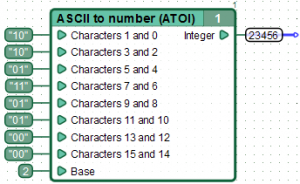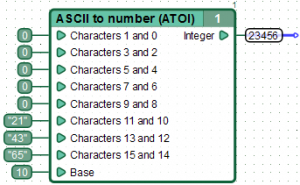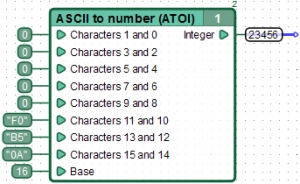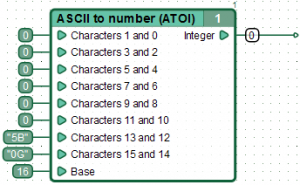| This documentation is out of date.
The new version of the documentation is here: https://cannylogic.com/docs |
Difference between revisions of "ASCII to Integer"
| [unchecked revision] | [unchecked revision] |
| (2 intermediate revisions by 2 users not shown) | |||
| Line 7: | Line 7: | ||
!colspan="2" style="background-color:#AFEEEE;"|Appearance | !colspan="2" style="background-color:#AFEEEE;"|Appearance | ||
|- | |- | ||
| − | |colspan="2" align="center" style="padding:10px;"|[[ | + | |colspan="2" align="center" style="padding:10px;"|[[File:5_10_5_2.png]] |
|- | |- | ||
!colspan="2" style="background-color:#AFEEEE;"|Symbol | !colspan="2" style="background-color:#AFEEEE;"|Symbol | ||
| Line 44: | Line 44: | ||
<div style="min-height:100%;display:block;"> | <div style="min-height:100%;display:block;"> | ||
<div style="float:left;width:70px;"> | <div style="float:left;width:70px;"> | ||
| − | [[ | + | [[File:5_10_5_1.png|left|Icon]] |
</div> | </div> | ||
<div> | <div> | ||
| − | Converts the string representation of a number for a given base 2, 10 or 16 | + | Converts the string representation of a number for a given base 2, 10 or 16 into a numeric value. |
| − | The original string must contain | + | The original string must contain valid characters in the selected numeral system on the positions: 0..15, 11..15 or 12..15 for a given base 2, 10 and 16, respectively. |
</div> | </div> | ||
| Line 61: | Line 61: | ||
In case of invalid characters presence on inputs, the value of the output will be set to 0. | In case of invalid characters presence on inputs, the value of the output will be set to 0. | ||
| − | In the case of using an invalid base value output value will be set to 0. | + | In the case of using an invalid base, value output value will be set to 0. |
== Examples == | == Examples == | ||
{| | {| | ||
|- valign="top" | |- valign="top" | ||
| − | |[[ | + | |[[File:5_10_5_3.png|thumb|«0101101110100000» base 2 = 23456]] |
| − | |[[ | + | |[[File:5_10_5_4.png|thumb|«0000000000123456» base 10 = 23456 (symbol "1" is supressed)]] |
|- valign="top" | |- valign="top" | ||
| − | |[[ | + | |[[File:5_10_5_5.png|thumb|«00000000000F5Ba0» base 16 = 23456 (symbol "F" is supressed)]] |
| − | |[[ | + | |[[File:5_10_5_6.png|thumb|«0000000000005BG0» base 16 = 0 (incorrect symbol "G")]] |
|} | |} | ||
Latest revision as of 13:47, 23 January 2016
| Appearance | |
|---|---|
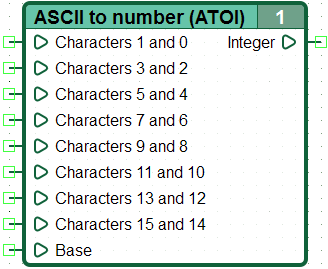
| |
| Symbol | |
| ATOI | |
| Group | |
| Converters | |
| Inputs | |
| Characters 1 & 0: | A pair of ASCII characters |
| ... | ... |
| Characters 15 & 14: | A pair of ASCII characters |
| Base: | Integer |
| Outputs | |
| Number: | Integer |
| Version CANNY Lab | |
| from 1.8 | |
Converts the string representation of a number for a given base 2, 10 or 16 into a numeric value.
The original string must contain valid characters in the selected numeral system on the positions: 0..15, 11..15 or 12..15 for a given base 2, 10 and 16, respectively.
Features
Symbols, which set outside of these position ranges, discarded.
In case of invalid characters presence on inputs, the value of the output will be set to 0.
In the case of using an invalid base, value output value will be set to 0.
Examples
Notes
With the release of CANNY Lab version 1.8 a new data presentation added - "A pair of characters" in which the values are represented by two characters ASCII with the codes given by high and low bytes of displaying 16-bit value .
For example, the decimal number 19778 corresponding hexadecimal 0x4B4E, displayed a pair of characters «KN», having ASCII-code 0x4B, and 0x4E respectively.
